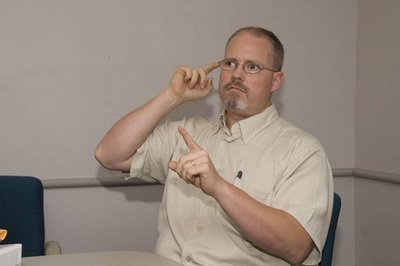September 27, 2007
ASL ‘spoken’ here: New class offered
This quarter for the first time, the UW will be offering American Sign Language (ASL) for credit. The class, which is offered in the Department of Linguistics, will continue through the year, each quarter building on the one before. There are also tentative plans for a class in deaf culture in the spring.
Lance Forshay, who has been deaf from birth and is a native speaker of ASL, has been hired to teach the class, which can be used by students to fulfill graduation requirements in foreign language.
The class is the culmination of a long-term effort to bring ASL to campus. (The University once had a Deaf Education Program with some ASL offered, but the emphasis was on signed English.) As far back as the 1980s, students have been interested in the subject, said Richard Ladner, who was instrumental in pushing for the class. A professor of computer science and engineering, he is the hearing child of deaf parents and has been active in working with the deaf community.
“Students have led petition drives and ASUW has passed resolutions calling for ASL instruction, but they didn’t succeed,” Ladner said. He said the last two ASUW presidents — Lee Dunbar and Cullen White — were both highly supportive of the project.
Two years ago, he decided to do what he could to make it happen. Thinking that linguistics would be a good home for the class, he called then-acting department chair Fritz Newmeyer, who was enthusiastic about the idea and suggested he talk to Linguistics Professor Sharon Hargus. Hargus worked with Ladner to prepare a proposal.
“Mainly, we gathered data,” Ladner said. “We found out that almost 600 colleges and universities around the country teach ASL, that 13 of 18 community colleges in Washington teach it, that Washington State University and Central and Eastern Washington Universities teach it. We found out that in 2004, 200 UW students took ASL, many to fulfill their foreign language graduation requirement, even though they had to go outside the University to get the classes.”
The proposal remained in the College of Arts and Sciences for a while as the former dean left the University and an interim dean was named. Then, last December, Ladner got word that some temporary funds from A&S and the Provost’s Office were being made available. Since then, those funds have been supplemented by a grant from the Norcliffe Foundation. Ladner also put up $10,000 per year for three years from his own Boeing Professorship to support the program. He said the Linguistics Department has been overwhelmingly enthusiastic about housing ASL.
Forshay, the new ASL lecturer, not only grew up speaking ASL in a mostly-deaf family, but also is a graduate of Gallaudet University in Washington, D.C., the world’s only four-year institution for the deaf. He has taught ASL for about 20 years in settings from high schools to community colleges to community groups. He said he will teach the UW class using the immersion method.
“When students come into the room, voices are to be off and it’s a quiet classroom,” Forshay said through an interpreter. “At the beginning of the course, ASL will be taught through pictures, through acting out and through drawing. As the students master the basic ASL vocabulary signs and grammar, I will move on to a more complex and advanced level of ASL, communicating exclusively in ASL and using a lot of visual aids.”
Except for the first few days of class, when he explains the syllabus and course requirements and gives a brief introduction to ASL history and deaf culture, Forshay said, he will not have an interpreter with him, and he does not read lips. So students will be forced to communicate as they would with any deaf person like himself — purely through gesture and then through ASL.
“It’s no different than if you went to Mexico and didn’t know Spanish,” Forshay said. “You would gesture to get your meaning across. Most people know quite a few gestural signs without realizing it. Some natural gestures are used in ASL vocabulary signs. And if a student forgets a sign, he or she can go back to use more informal gesturing as a bridge to ASL.”
Because the class is being offered to students with no previous training in ASL, Forshay will start with very basic conversational terms and go from there. He said there will be a lot of work in pairs and small groups in order to practice using the language.
Although two sections of ASL will be offered this quarter, Ladner said there are more than 300 people on the waiting list, illustrating the strong interest on campus.
Forshay thinks a fascination with the language itself helps explain the interest. “It’s a gestural language, so it’s very different than any spoken language such as Spanish or French,” he said. “Also, there’s a large deaf community in Seattle, so people have exposure to ASL.”
He added, “It involves working with the deaf community — a community that has its own unique culture, so I think often people are fascinated with that.”
Students will have a chance to learn about deaf culture in an Introduction to Deaf Studies class to be offered in the spring. ASL is not a prerequisite for that class, which will be co-taught by Forshay and Ladner. Forshay said it will include guest lectures by people from the deaf community.
Plans for the future include adding a second year series of ASL classes. But meanwhile, Ladner and others will be seeking money for the program. “That’s our next job,” he said, “to get permanent funding.”



